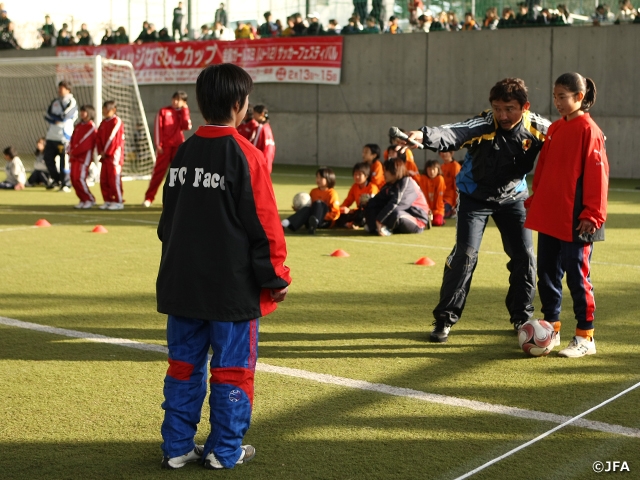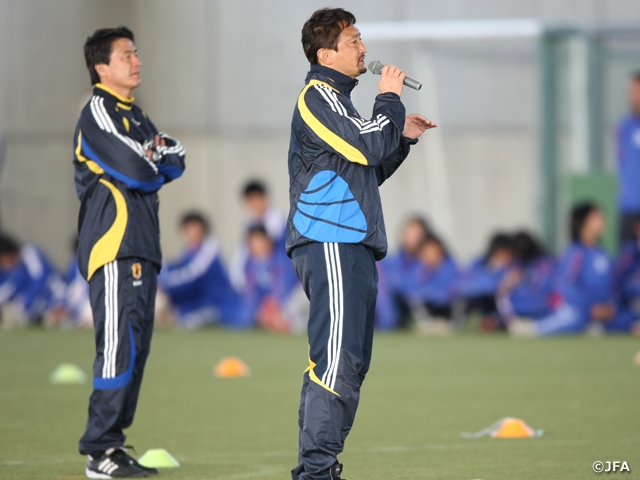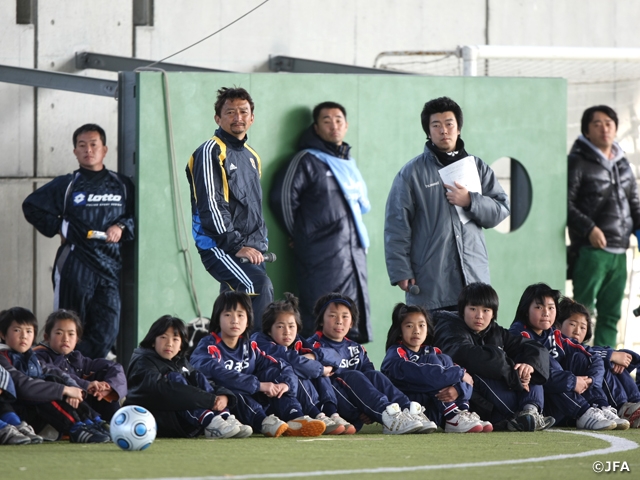NEWS
“Taking the path of reconstruction together with the kids of the academy and the hearts of the locals” 10 years since the Great East Japan Earthquake – Relay Column Vol.9
25 March 2021

It has been 10 years since the Great East Japan Earthquake. While the restoration has progressed with a ton of support from home and abroad, there is still a long way to go for a full recovery. Here we will deliver essays and columns of people involved in football, reflecting on their own experience and perspective on the Great East Japan Earthquake.
The ninth column will be based on the story of Mr. IMAIZUMI Morinao, the Director and Head Coach of the JFA Academy Fukushima Girls’ team when the Great East Japan Earthquake struck.

JFA Academy Fukushima is a system in which JFA has worked to incorporate football into school education since April 2006 in collaboration with Fukushima Prefecture, Hirono Town, Naraha Town, and Tomioka Town. Many young talents are gathered from all over the country, but the purpose of this academy, which covers the six years from junior high school to high school, is not necessarily limited to football. Through its combined junior/senior high school education, the academy puts an emphasis on the importance to coexist with the local people. Their activities were based at J-Village, but the dormitories were built in different school districts for boys and girls, so they went to different junior high schools, as boys went to Hirono Junior High School while girls went to Naraha Junior High School. Once reaching the high school age, they will both advance to Tomioka High School in Futaba District. At the same time as the academy was established, the international sports department was newly established at Tomioka High School, in which athletes from other sports such as MOMOTA Kento of badminton were also enrolled.
At that time, a total of 125 academy students were enrolled for both boys and girls. The graduation ceremony of Naraha Junior High School was held in the morning of 11 March 2011. At that time, Imaizumi felt an unusual shake during a meeting in Tomioka Town. The national highway on the way back from Tomioka to Naraha had caved-in everywhere. The announcer was screaming from the radio that “The tsunami was coming.” Fortunately, there were not much damage caused to his house, but there were many collapsed houses in his neighbourhood. Many of the students who attended the graduation ceremony had went out to eat in Iwaki City with their parents. The other academy students were preparing for thgeir afternoon training session. “We were fortunate that the kids were all in one place.” Locals were also seen evacuating to the gymnasium of J-Village. To avoid congestion, he decided to return to the girl's dormitory. While the power was lost, he made everyone bring out their futons in the first floor lobby and spent the night together. At that time, no information on the damage came in.
The situation changed on the next day. An evacuation order was issued through cable broadcasting. “We were told to go south. But before that, we were told not to move, so we were not sure what to do. But soon afterwards, we were contacted again, this time saying ‘Mr. Imaizumi, please evacuate to Iwaki right away.’ And that was when we left the dormitory.” Since the school bus was at the boy's dormitory in Hirono, the girls boarded the staffs’ car and headed for Iwaki City. Our meeting point was Taira No.4 Primary School. The school was not designated as an evacuation site, but when we explained the situation to the principal and vice-principal, they offered to release their gymnasium for us. In the midst of the turmoil, I had no idea how the boys evacuated from Hirono Town, because our highest priority was to move the girls safely. But we soon learned that the boys had evacuated to Chuo Dai Minami Primary School, which was the designated evacuation site of Hirono Town. After contacting coach Nakata of the Academy boys’ team, we decided to gather both teams in one place. In the evening, the boys also moved to the gymnasium of Taira No.4 Primary School, while the girls who attended the graduation ceremony also joined soon afterwards. The following day, on the 13th, the academy students were transported to Ajinomoto National Training Centre in Nishigaoka by two large buses that picked them up from Tokyo, before they were sent home on the 14th.
After moving to Tokyo on the 13th, Imaizumi stayed at a hotel near JFA to collect information. Discussions among the various parties continued every day. The outlook was bleak. With J-Village becoming a base for nuclear power plant countermeasures, it will be difficult for the Academy to carry out future activities in Fukushima. That was obvious to everyone’s eyes. “We knew how devastated Tomioka, Naraha, and Hirono were, so we knew that we would not be able to return so easily.”
On 30 March, TASHIMA Kohzo (current JFA President) who was then JFA Vice President and Academy School Master, was accompanied by Imaizumi and other staffs to visit Fukushima Prefecture and gathered information. After seeing the situation, he knew it would take several years for reconstruction. The academy which started with a big vision was in danger of survival. However, even in such difficult situations, the people involved did not disband the academy. On the premise of returning to Fukushima Prefecture in the end, they searched for a base for the academy outside the prefecture.
Local governments and universities have offered to accept the academy. Despite the circumstances, the relocation destination was decided on 31 March from multiple candidates. The destination was Tokinosumika in Gotemba City, Shizuoka Prefecture. The site had several well-maintained football fields and accommodation facilities. Furthermore, Tokinosumika had the best chance of holding the activities of both boys and girls within the same facility. There were no issues surrounding the environment for playing football, but there were issues regarding the educational aspect. Since junior high school is compulsory education, students of Naraha and Hirono Junior High School could transfer to Fujioka Junior High School, which is within the school district of Tokinosumika. However, it was a different story for the high school students. The teachers of Tomioka High School, where the academy students attended, had evacuating to Koriyama Kita Technical High School, while students from other sports, such as badminton and golf, were also transferred to high schools within Fukushima prefecture. Transferring high school students across prefectures was not an easy task.
“Ultimately, it came down to the decision between he governor of each prefecture. Governor KAWAKATSU Heita from Shizuoka Prefecture and Vice-governor UCHIBORI Masao from Fukushima Prefecture held a conference and reached an agreement to transfer the students of Tomioka High School to Shizuoka.” Fortunately, Tomioka High School was a credit-based school since it was in Fukushima, so the students just needed to take the prerequisite courses while fulfilling the required credits for graduation. The recipient was Mishima Choryo High School, which is about 30 minutes by bus from Tokinosumika, and also a credit-based school. At the beginning of the new school year, two teachers were dispatched from Tomioka High School to Mishima Choryo High School, who were in charge of the academy students. By doing so, they were essentially allowed to establish a satellite school of Tomioka High School, which was renting the school facility of Mishima Choryo High School, allowing the academy students to resume their high school life without getting interrupted.
In April 2018, JFA announced plans to return JFA Academy Fukushima from Shizuoka prefecture to Fukushima prefecture. According to the plan, boys will return in April 2021, while the girls will make their full return in 2024. “The people in Fukushima who are in contact are also looking forward for this plan to bring back the academy to Fukushima. Of course, reconstruction has a material element, but I think the most important thing is the reconstruction of the human mind. We would like to walk along the path of reconstruction together with the kids of the academy and the hearts of the locals. I also want to return to Naraha at the end. It's a really nice place.” It has been 10 years since the earthquake. From the United States where he currently resides, Imaizumi thought of Fukushima by saying so.

Related News
-
2021/03/24
“Together with J-Village” 10 years since the Great East Japan Earthquake – Relay Column Vol.8

-
2021/03/23
“10 years of Sports Kokoro Project, which tried to be considerate of children’s feelings” 10 years since the Great East Japan Earthquake – Relay Column Vol.7

-
2021/03/22
“Please remember what happened in Tohoku on 11 March and think about your own safety” 10 years since the Great East Japan Earthquake – Relay Column Vol.6

-
2021/03/19
“We want the boys in the affected areas to take over the Tohoku Spirit” 10 years since the Great East Japan Earthquake – Relay Column Vol.5

-
2021/03/18
“The smiles of the children taught me what it means to coach” 10 years since the Great East Japan Earthquake – Relay Column Vol.4

Latest News
-
National Teams
2024/04/30
【Match Report】U-23 Japan National Team book their ticket to the Paris Olympics with victory over Iraq in the AFC U23 Asian Cup Qatar 2024™ semi-final

-
National Teams
2024/04/26
【Match Report】U-23 Japan National Team defeat host nation to reach semi-finals of the AFC U23 Asian Cup Qatar 2024™

-
National Teams
2024/04/23
【Match Report】U-23 Japan National Team lose to Korea Republic to advance to knockout stage as runners-up - AFC U23 Asian Cup Qatar 2024™

-
National Teams
2024/04/20
【Match Report】U-23 Japan National Team advance past group stage with two consecutive clean sheets - AFC U23 Asian Cup Qatar 2024™

-
National Teams
2024/04/17
【Match Report】U-23 Japan National Team win first group-stage match despite playing with 10 men following first-half sent-off - AFC U23 Asian Cup Qatar 2024™


